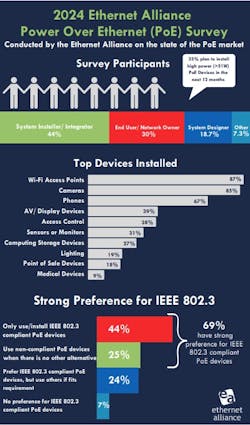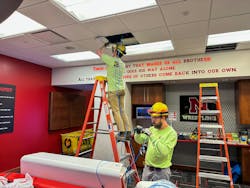Lighting is a lightning rod for Power over Ethernet (PoE). With publication of the IEEE 802.3bt standard in September 2018, PoE gained the ability to support up to 90W. That made it a good fit for lighting applications that traditionally required an AC outlet. But in the process, 802.3bt opened the door for non-electricians to install lighting, such as audio-video (AV) integrators, security firms, and other contractors who specialize in low-voltage applications. That prompted the electrical industry to lobby for state building code changes to stave off new competition by moving the high-voltage/low-voltage demarcation line. One example from Utah was lowering Class 2 wiring voltage from 100V to 50V.
“The controversial technology is LED lighting,” Chuck Wilson, executive director of the National Systems Contractors Association (NSCA), told EC&M in 2019. “One of the concerns electricians have right now is lighting is going low voltage.”
Five years later, PoE lighting is a relatively niche application, regardless of who’s installing it. In early 2024, the Ethernet Alliance surveyed companies that design and install PoE equipment, as well as those that own and manage it, such as enterprise IT departments. Only 19% of respondents said they use it for lighting, making it No. 8 on the list of most common PoE applications (Fig. 1).
“Right now we are seeing PoE mostly with networked lighting control systems in commercial settings,” says Collin Weiner, president of CalEnergy Corp., which specializes in California Title 24 energy compliance. “PoE is increasingly used in lighting systems for its ability to power and control LED luminaires, either utilizing integrated fixture controls, distributed control systems, or centralized. In addition to being more cost-effective by cutting down on labor and material costs, PoE systems allow for a more flexible and energy-efficient lighting solution. This is especially true in commercial buildings where additions, alterations, and tenant improvements of spaces are common.”
In some cases, PoE is complementing rather than replacing AC.
“We were seeing a push for PoE in the lighting world,” says Eric Hoge, vice president of engineering at Des Moines, Iowa-based Commonwealth Electric Company of the Midwest. “However, we have had a couple of clients move away from PoE because of issues with the product and Ethernet switches. We are seeing a bigger move toward networking the controls system but using line voltage at the fixtures. The drive for these types of systems is the ability to control either zones or individual lights using Wi-Fi.”
Commonwealth used wireless for recent projects such as the Nebraska Medicine Fred & Pamela Buffett Cancer Center.
“The application is not PoE in a strict sense since the lights are powered by line voltage,” Hoge says. “However, these systems are still controllable at a granular level like PoE fixtures are. The drawback is that each zone or fixture to be controlled will require a switching mechanism such as a relay that is controlled by the devices.”
Hoge is bullish about PoE lighting over the long term.
“Our biggest challenge is just the technology itself,” he says. “It has come a long way over the past 10 years, but there are still improvements that need to be made to gain widespread acceptance. I think it is like LED 15 years ago. Compact fluorescent was the fixture of choice over incandescent for energy savings. LEDs were in the market, but the technology had not been refined, and the fixtures were not cost-effective.”
Today, Hoge says LED technology is the primary choice on all of our projects. “I have zero doubt that PoE is the next step for energy efficiency in every facility,” he says. “The ability to measure and manage our energy use will be huge.”
Less is more
One aspect of PoE’s future is certain: It’s unlikely to get another wattage boost.
“We wrote 802.3bt with the idea that it was the last multipair PoE standard because once you go past 100W, the rules change around installation practices both in the U.S. and Europe,” says Chad Jones, an Ethernet Alliance member and chair of the IEEE P802.3bt task force.
Currently, most market demand is for products well below the 90W maximum.
“The next largest sales point is the Class 6 power source equipment,” says David Tremblay, Ethernet Alliance PoE subcommittee chair. “That’s up to 60W capability. Marketing research shows that there’s a growing opportunity for Class 8, but we just aren’t seeing that take over the Class 4 and Class 6 demand.”
Energy efficiency is another marketplace factor. Although 90W PoE enabled more lighting applications and competitors, LED efficiency also is key. This trend is playing out with other devices, which highlights potential business opportunities for electrical contractors.
For example, some commercial video displays are now so energy efficient that PoE can provide both their power and data. In the 2024 Ethernet Alliance survey, 39% of respondents said they’re using PoE for displays, making them the No. 4 most common device. Electrical contractors might see all that as a reason to expand into the digital signage market with design and installation services instead of just pulling power cables as a sub to AV integrators.
“Absolutely contractors will expand, and it’s very exciting,” says Weiner, whose NECA 2023 presentation focused on “How Lighting Controls Can Revolutionize Service and Maintenance.” “The trends of increasing energy efficiency in connected devices and the growing power capabilities of PoE are indeed expanding the range of applications where it can be the sole source of power and data. The combination of these trends along with the introduction of Class 4 fault-managed power opens up new possibilities and opportunities in various sectors.”
Cutting the cord
Some electrical contractors are leveraging PoE to expand into the indoor wireless market. Wi-Fi access points (APs) were the most common PoE device in the 2024 Ethernet Alliance survey.
“One of the challenges we occasionally come across with a client is trying to communicate what is truly required to create a strong, stable network,” says Heath Eastman of Kingston, N.H.-based Eaton & Eastman Electric. “While they may understand the need for good Wi-Fi coverage, it can be difficult to convey how critical the complete system with all of the necessary components truly is. A solid network has become a necessary foundation to ensure proper communication and operation of the equipment that is being utilized in today’s homes and businesses. PoE helps us with the ease of installation as well as a cleaner finished look for the client.”
Another wireless opportunity is indoor cellular “small cells,” which look like Wi-Fi APs but provide 4G and 5G connectivity in malls, airports, and other public places. Some small cell products are available in AC and PoE versions, with technology that helps automate network design aspects, such as site surveys, to identify the ideal installation locations. But as with Wi-Fi, digital signage, and other non-lighting applications, electrical contractors need to acquire some cellular skills to be successful and compete with telecom specialists.
“Certainly electrical contractors are free to go learn that skill and advertise it and do the job,” says Ethernet Alliance’s Jones. “But it’s not something that your typical electrical contractor will know how to do, and it’s not something you learn in a day.”
Small cells and Wi-Fi APs also can create upsell opportunities for electrical contractors. For example, the client might initially want Wi-Fi for broadband access but then be receptive to other applications that use it for connectivity, such as Internet of Things (IoT) sensors and controllers for smart home/smart building systems.
“As IoT continues to grow, PoE becomes a convenient and efficient way to power and connect a variety of IoT devices, such as smart lighting systems, security systems, HVAC systems, and distributed energy resources,” Weiner says. “I predict this will eventually contribute to the development of a smart building under one converged system, replacing the structured cabling system and effectively siloing the different building systems, which is the current practice.”
All together now
There’s no shortage of PoE devices and manufacturers to choose from, but some contractors prefer to stick with one brand to ensure that everything just works.
“We typically install new systems with matching components from the manufacturer to help ensure the ease of installation and solid communication between the equipment,” says Eastman, who also serves as This Old House master electrician.
However, many PoE installations are multivendor environments because they’re an expansion of the client’s existing system or because no single manufacturer can meet all of the project’s requirements. In those cases, vendor interoperability and technology generations are important considerations. 802.3bt is designed to be backward compatible with 802.3af and 802.3at products, but there’s no guarantee that it will support PoE++ devices because that’s a proprietary version — read more on PoE++ and its potential drawbacks.
Older power source equipment (PSE) might not be able to adequately support newer devices. For example, if a legacy 802.3af Class 3 PSE connects to a newer 802.3bt Class 6 device, the latter will be “power demoted.” This process occurs when the device and PSE initially connect and exchange information about their capabilities. The device will then start disabling features to ensure it doesn’t draw more power than the PSE can provide.
The Ethernet Alliance’s PoE Certification Program helps electricians quickly identify power levels via logo marks that vendors put on products and in documentation. For instance, if the PSE logo number is greater than or equal to the device’s logo number, then the latter won’t be power demoted.
That’s also an example of how the certification program aims to address some of the problems that were flagged in the 2024 Ethernet Alliance survey. For instance, 15% said “power/operation unreliable” is a major problem (Fig. 2).
The program also can help with multi-vendor installations.
“This was one of the main reasons for the certification program: to reduce interop issues,” Jones says. “Something that has an Ethernet Alliance certification is exceedingly less likely to have interop issues.”
Nice work — if you can get It
Understanding these kinds of nuances and caveats goes a long way toward ensuring competitiveness and profitability in the PoE market.
“The largest challenge I see for electrical contractors, low voltage, or AV integrators looking to be successful in this space will be high-level education and training for their team,” Weiner says. “Staying updated on the evolving PoE standards, technologies, and manufacturer best practices requires ongoing education and training. Contractors need to invest in keeping their teams knowledgeable about the latest advancements in PoE to provide optimal solutions for clients. Training programs offered by the Ethernet Alliance and the PoE Consortium will be a valuable resource to keep your team a step ahead.”
In the Ethernet Alliance survey, video surveillance and access control were the second and fifth most common applications, respectively. But successfully targeting those markets doesn’t necessarily mean adding or training employees. It could be faster, cheaper, and less risky to partner with firms that specialize in those applications. Their brand recognition also can help open doors, such as with the IT departments responsible for all Ethernet-based applications.
“By leveraging each other’s strengths, sharing expertise, and staying abreast of technological advancements, they can collectively provide optimal solutions for clients in the evolving landscape of PoE systems, Class 4 fault-managed power, and converged smart building systems,” Weiner says.
This strategy also can be a way to turn competitors into partners.
“As the technology continues to emerge and become more powerful, electrical contractors without a limited energy/low-voltage group are going to be faced with losing a part of their market share,” Hoge says. “These systems can be installed quickly without the necessity of conduit installed by electricians. Technicians are going to be qualified to complete the work.
“Even for contractors with low-voltage teams, there is a steep learning curve to be able to compete as an integrator. That means design and programming expertise will be required at the contractor level. To take the discussion just a little further, does that put the electrical contractor in the same arena as the mechanical contractor for supplying control systems? It certainly is going to be fun watching how the market changes over the next few years.”






